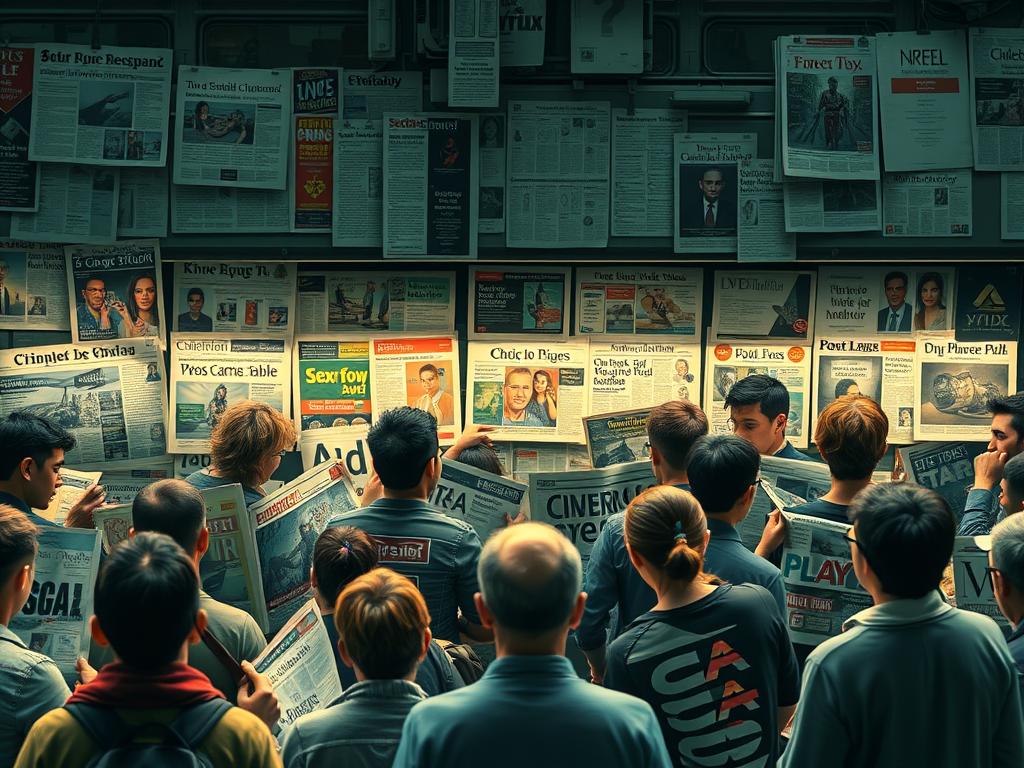In today’s rapidly evolving media landscape, one profound disadvantage of newspaper advertising is its print media limitations. Despite the longstanding credibility of newspapers, numerous factors contribute to newspaper ad ineffectiveness and challenges in demographic targeting. The most pressing issue facing newspaper advertising today is the significant decline in readership.
In 2017, total newspaper circulation stood at 31 million on weekdays and 24 million on Sundays. This quick snapshot pales in comparison to the combined circulation of dailies in 2005, which was 54.6 million and dropped to 40.4 million by 2015. Double-digit declines in readership amplify the limitations of print media as newspapers struggle to compete with online mediums.
Young adults aged 18 to 35 are increasingly consuming news from social media platforms, contributing to the demographic targeting challenges faced by newspaper advertisers. With only around 6% of adults aged 18 to 24 receiving daily papers and approximately 10% of adults aged 25 to 45 doing the same, newspapers find it challenging to reach a diverse audience effectively. This limited audience reach impacts the cost per reader and possibly increases the risk for businesses choosing newspaper ads over other forms of advertising.
Moreover, the advertising pricing model based on circulation, ad size, frequency, and placement section adds complexity and uncertainty in achieving a solid ROI. In contrast, digital mediums, with their pay-per-click models, provide detailed tracking of ad views, clicks, and responses, presenting a much more dynamic and responsive option.
As readership trends shift and younger consumers favor mobile media over print newspapers, the future of newspaper advertising seems increasingly uncertain. The short shelf life of daily newspaper ads, compounded by visual clutter from multiple competing ads, reduces the effectiveness and engagement of individual advertisements. Understanding these limitations is essential for modern marketers to adapt their strategies accordingly.
Declining Readership and Limited Audience Reach
The decreasing readership of newspapers presents a substantial challenge for traditional print advertising. The decline in circulation, from 54.6 million in 2005 to 40.4 million in 2015, indicates that fewer people are engaging with newspapers as a source of information. Particular demographics such as young adults (ages 18-24) show minimal engagement with daily papers, making it difficult to reach specific audience segments effectively.
Understanding the Impact of Decreasing Readership
Younger audiences are increasingly consuming news online, which contributes significantly to the newspaper readership decline. This demographic shift is exemplified by the rise of digital media, compelling traditional newspapers to struggle in maintaining their circulation numbers. With readers increasingly gravitating towards digital platforms, the traditional newspaper format becomes less appealing, further reducing the potential audience for print ads. Additionally, the environmental impact of printing newspapers, coupled with concerns about paper consumption and waste, persuades eco-conscious consumers to seek alternative news sources.
How Limited Audience Reach Affects Advertising Success
The limited audience reach of newspapers poses significant challenges for advertisers. As fewer people read newspapers, the advertising reach diminishes, making it harder for companies to achieve their desired campaign outcomes. This situation is exacerbated by the fact that newspaper ads are not as precise in targeting specific demographics compared to digital tools or online advertising. Furthermore, since newspapers have a short shelf life—typically being read for only a day before being discarded—ads quickly become outdated. To compound matters, readers may skip over advertisements, especially if they are not prominently placed or visually engaging.
| Media Type | Audience Reach | Lifespan |
|---|---|---|
| Newspapers | Limited | Short (1 day) |
| Digital Media | Extensive | Long (permanent) |
| Radio | 90% of adults weekly | Varies |
| Online Radio | 57% monthly | Long (recurring) |
Cost Considerations in Newspaper Advertising
When delving into newspaper advertising expenses, businesses must weigh several crucial factors. The average newspaper ad cost for a one-inch column, black-and-white print ad in 2024 is $756.40, which can be prohibitive for small businesses seeking cost-effective marketing solutions. Compared to the range of costs for online publication ads, which fluctuate between 3 cents and $5 per click, print advertising costs appear significantly higher.

Let’s consider the investment required for ads in national newspapers like the Wall Street Journal, which start at a staggering $1,576. These numbers climb even higher with full-page ads. For instance, a black-and-white full-page ad in the Wall Street Journal ranges from $200,000 to $250,000, while a color ad costs between $250,000 and $300,000. This steep pricing underscores why careful consideration of advertising expenses is essential.
Another essential aspect is the cost-to-benefit ratio. While a full-page ad in the Wall Street Journal or The New York Times may reach a large audience, the actual percentage of readers engaged by these ads might be relatively low. In contrast, the average cost per click for digital publications ranges between five cents and $3, providing a more cost-effective marketing avenue.
Digital platforms like nytimes.com, cnn.com, and foxnews.com boast monthly visits ranging from 165.3 million to 503.4 million, offering a vast audience at a fraction of the cost. A comparative table highlighting these costs and reach metrics may illuminate the differences:
| Ad Medium | Average Cost | Audience Reach |
|---|---|---|
| Newspaper (1-inch B&W) | $756.40 | Limited |
| WSJ Full-Page (Color) | $250,000 – $300,000 | High |
| Online Publication Ad | $0.03 – $5 per click | High |
| Google Search Engine Ad | $0.305 CPC | High |
| Social Media Ad (Facebook/X) | $0.38 CPC | High |
Given these figures, businesses must critically assess whether the investment in print advertising costs justifies the reach and engagement, especially with the alternative cost-effective marketing strategies available today.
Competing Ads and Distractive Content
In the realm of newspaper advertising, advertisers often face significant ad visibility challenges due to overwhelming advertising clutter. This abundance of advertisements can overshadow individual ads, making it difficult for a specific message to capture the reader’s attention. With competing content distractions, consumers may not only miss your ad but also fail to engage with its message, reducing the overall effectiveness of your advertising efforts.
The Challenge of Standing Out
Newspapers frequently feature a wide array of competing advertisements, leading to an environment where standing out becomes challenging. The cluttered pages can diminish the impact of branding efforts, as individual ads struggle to capture the reader’s focus amid the sea of other content. Furthermore, readers don’t always peruse the entire newspaper, increasing the likelihood that your ad will go unnoticed. This intensifies the ad visibility challenges that marketers face in print media.
How News Stories Affect Ad Visibility
Editor-selected content and news stories compound the issue of ad visibility challenges by diverting readers’ attention away from advertisements. While compelling news articles keep readers engaged, they inadvertently create competing content distractions that make it harder for ads to stand out. Consumers may prioritize absorbing current events over paying attention to the surrounding advertisements, thus impacting the success rate of ad campaigns in newspapers. To learn more about the advantages and disadvantages of different ad formats, you can check out this informative article.
Ultimately, the blend of advertising clutter and compelling editorial content requires advertisers to rethink their strategies within print media, considering the unique challenges and opportunities presented by this traditional channel.
A Disadvantage Of Newspaper Advertising Is That It Lacks Targeting Flexibility

One significant issue with newspaper advertising is the targeted marketing limitations inherent in print media. Unlike digital platforms where you can specify precise demographics, newspaper ads are restricted by their broad demographic reach. Although newspapers might cater to certain regions or general interests, advertisers struggle with ad placement inflexibility. This hinders the ability to narrow down target groups based on specific age brackets, income levels, or consumer behaviors.
Advertisers often lament that the lack of targeting flexibility in newspapers prevents them from optimizing their ad spend. When aiming to catch the attention of niche markets, the broad stroke approach of print advertising proves inefficient. It’s challenging to focus on particular psychographics, ultimately limiting the strategic positioning of ads. For instance, a luxury brand targeting affluent consumers might find the vast reach of a newspaper both a blessing and a curse—the ad might reach a wide audience but not necessarily the desired high-income demographic.
Print advertising does have its strengths, such as high trustworthiness and the ability to engage readers effectively. However, the higher costs and slower turnaround times associated with designing, printing, and distributing print ads add to the challenges. Moreover, tracking the effectiveness of print ads is more complicated compared to digital ads, where real-time analytics provide instant feedback. Thus, while print media can complement online campaigns to create a cohesive brand message, its targeted marketing limitations and ad placement inflexibility remain substantial drawbacks.
In essence, while newspaper ads can reach offline audiences in specific geographical areas efficiently, they lack the precision and adaptability that modern advertisers require to optimize their campaigns fully. This demographic reach is particularly limiting when advertisers seek to appeal to narrower audience segments, resulting in less efficient and potentially less effective advertising efforts.
Short Shelf Life of Newspaper Ads
Newspaper advertisements are plagued by several obstacles, with one of the most significant being their short shelf life. These ads are typically read and then quickly discarded, minimizing the ad exposure duration and ultimately reducing the lasting impact on the consumer.
Frequency and Timing Issues
The rapid frequency of new editions exacerbates these timing issues. If a consumer doesn’t engage with the publication on the day of its release, your ad misses its window of opportunity for visibility. Unlike digital ads, which can remain accessible for extended periods, newspaper ads have a very limited lifecycle. This brief ad exposure duration can severely impact brand memory recall.
Effect on Brand Recall and Engagement
Given the transitory nature of newspaper ads, maintaining consumer engagement and achieving effective brand memory recall can be challenging. Readers often skip over ads that aren’t prominently placed or visually captivating. Moreover, the lack of tracking and analytics in print media makes it difficult to measure the success and consumer engagement of your advertisements accurately.
Conclusion
In conclusion, while newspaper advertising has long been regarded as a reliable medium, it is important to consider its limitations in today’s rapidly evolving media landscape. The declining readership rates and limited audience reach challenge the effectiveness of print media. Additionally, the competing ads and news stories further complicate efforts to capture reader attention. As a result, accurately evaluating advertising mediums becomes essential for your marketing strategy.
Cost considerations and the short shelf life of newspaper ads also play a significant role in shaping advertising effectiveness. Although negotiations with media companies can yield price reductions and better ad placements, the inflexibility in targeting specific demographics remains a notable drawback. This underscores the need for a well-rounded marketing strategy that leverages various channels to maximize reach and engagement. For instance, running multiple print campaigns throughout the year may offer discounts and improve overall cost-effectiveness.
While newspapers boast credibility and tangibility, it is crucial for businesses to assess their specific needs, target demographics, and the advantages of digital platforms when designing their marketing plans. By integrating cross-platform approaches, you can optimize the reach of your campaigns and foster stronger connections between brands and consumers. Evaluating advertising mediums and staying adaptable to the digital landscape will ensure your marketing strategy remains relevant and effective.








